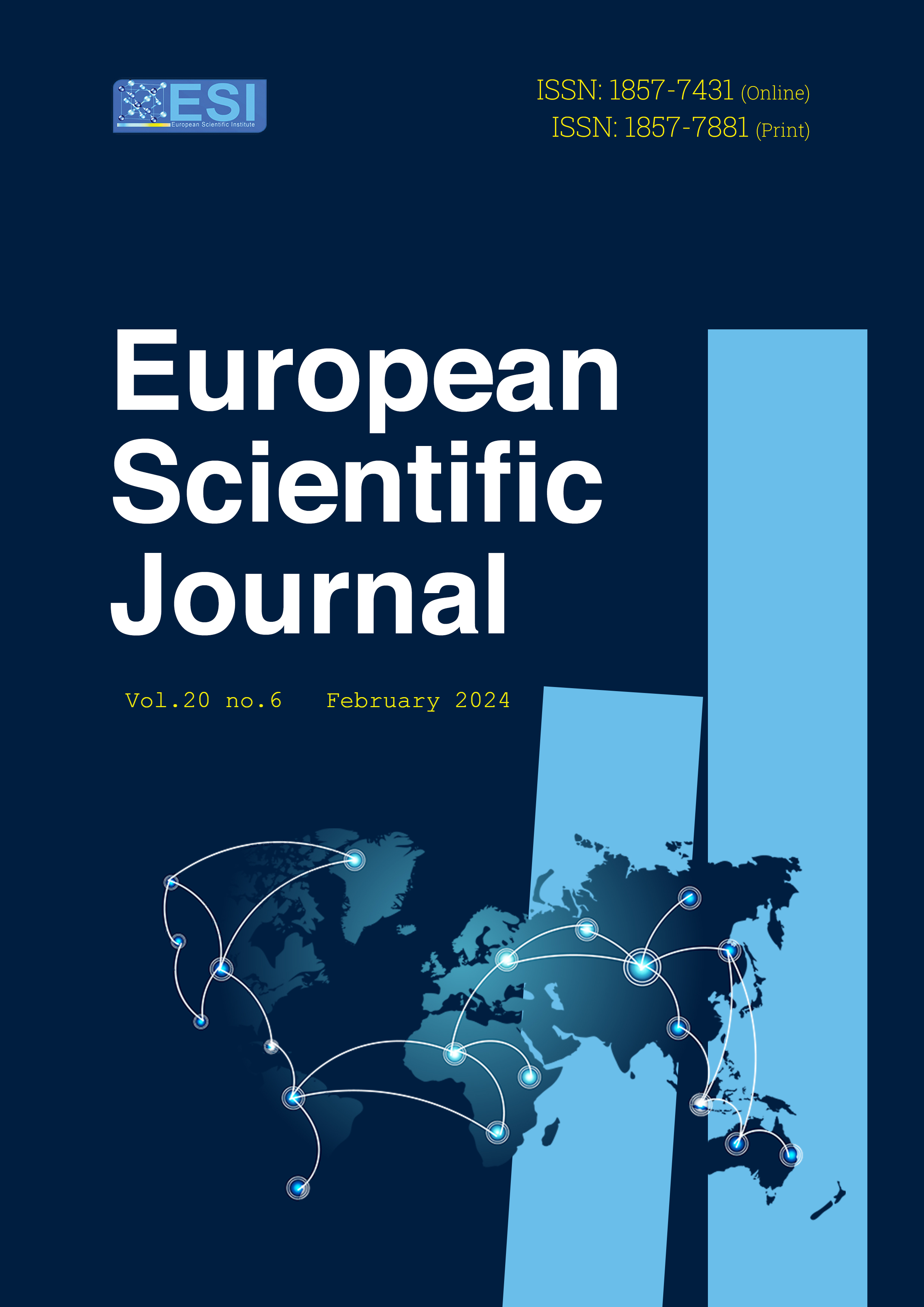Vermicomposting of Sludge from the Camp SIC Cité-Verte Wastewater Treatment Plant (Yaounde-Cameroon)
Abstract
In Yaounde, as in most sub-Sahara African cities, wastewater management is a major concern. Through its national sanitation strategy, Cameroonian government takes many initiatives to improve the urban sanitation situation by constructing social housing, where wastewater treatment plants are integrated. However, their purification performance is often low and the by-products represent great risk factors. This paper focuses on preserving the health of the population, reducing environmental pollution, and improving soil fertility by vermicomposting sludge from the Yaounde Camp SIC Cité-Verte wastewater treatment plant. The methodological approach consisted of the characterisation of sludge, followed by the vermicomposting test. At the end of the 35-day process, the produced vermicompost was characterized, and its agronomic efficiency was tested on waterleaf (Talinum triangulare) cultivation. The Yaounde Camp SIC Cité-Verte wastewater treatment plant consistently produces an average of 239 Kg of sludge per day. The sludge is primarily composed of high carbonaceous material (53%) and contains essential nutrients for plant growth (NPK: 13%), along with pathogenic microorganisms and heavy metals in low concentrations. The characterisation of the vermicomposts obtained after 35 days showed a conservation of nutrients (NPK) concentration and a decrease in carbonaceous matter and heavy metals. Moreover, there was a complete absence of fecal pathogens in the vermicompost of the two setups. The agronomic efficiency of the vermicomposts on waterleaf was shown by a high germination rate (100 % for vermicomposts), a high number of leaves (28 ± 15), a deep green coloration of plants, a great plant length (17.3 ± 4.6 cm), and a large stem diameter (2.1 ± 0.4 cm). The NPK content (˃7%) indicates that the vermicompost produced can be used as an agricultural organic fertilizer.
Downloads
Metrics
PlumX Statistics
References
2. Amir, S. (2005). Contribution à la Valorisation de Boues de Stations d’Epuration par Compostage : Devenir des Micropolluants Métalliques et Organiques et Bilan Humique du Compost. Thèse de Doctorat, Institut National Polytechnique, Toulouse, France.
3. ANOR NC-2867 (2021). Environnement-Exigences relatives aux rejets des effluents liquides industriels. Agence des Normes et de la Qualité, ICS N°13-030-40, 71 p.
4. Bhat, S. A., Singh, J., & Vig, A. P. (2017). Instrumental characterization of organic wastes for evaluation of vermicompost maturity. Journal of Analytical Science and Technology, 8(2), 12p.
5. Bhat, S. A., Singh, J., & Vig, A. P. (2015). Potential utilization of bagasse as feed material for earthworm Eisenia fetida and production of vermicompost. Springerplus. 28p.
6. Bouzid, M. & Djadi A. (2015). Revaluation of activated sludge and chicken manure through composting by aerobic process. Afr. J. Agric. Res., 10(52), pp 4831-4836.
7. Chennaoui, M., Salama, Y., Makan, A., & Mountadar, M. (2016). Valorisation agricole d’un compost produit à partir du compostage en cuve des déchets municipaux. ESJ, vol. 12, N° 35, pp 247-265.
8. Etsè, A., Sanonka, T., Kokou, S., Magnoudéwa, B. B., Kokou, D., Koffi, K. A., Gado, T., & Gnon, B. (2014). Etude de la disponibilité du phosphore assimilable des composts des déchets urbains dans deux sols différents. European Scientific Journal, ESJ, 10(6), pp 156-167.
9. Fabien (2021). Reconnaitre les carences des plantes d’aquarium. Aqua Store, 4 p.
10. Fernando, M., Aira, M., & Jorge D. (2009). Changes in bacterial numbers and microbial activity of pig slurry during gut transit of epigeic and anecic earthworms J. Hazard. Mater. 162, pp 1404-1407.
11. Glenn Munroe (2020). Guide du lombricompostage et de la lombriculture à la ferme. Centre d’agriculture biologique du Canada, 37 p.
12. Gnagne, Y. A., Yapo, B. O., Meite, L., Kouamé, V. K., Gadji, A. A., Mambo, V., & Houenoul P. (2015). Caractérisation physico-chimique et bactériologique des eaux usées brutes du réseau d’égout de la ville d’Abidjan. Int. J. Biol. Chem. Sci., 9(2), pp 1082-1093.
13. Gnanasekaran, R., Jerin Rexiya, S., Dhanalakshmi, M., Abinaya, M., Priyadharshini, B., Sharmilee, D., & Udayamathi, M. (2023). Utilization of Lagerstroemia speciosa dry leaf litter combined with cattle dung for the production of enriched vermicompost – A possibility of valorization. International Journal of Recycling of Organic Waste in Agriculture, 12(4), pp 699- 708.
14. Kathy Donohoe (2018). Chemical and Microbial Characteristics of Vermicompost Leachate and their Effect on Plant Growth. Doctor of Philosophy thesis, School of Life and Environmental Science, University of Sydney, 287 p.
15. Kavita Sharma & Garg, V. K. (2020). Conversion of a toxic weed into vermicompost by Eisenia fetida : Nutrient content and earthworm fecundity. Bioresource Technology Reports, volume 11, page 100530.
16. Liegui Ginette Sandrine (2019). Une alternative durable de valorisation des déchets organiques ménagers en maraichage périurbain à Yaoundé (Cameroun). Mémoire de fin d’études de Master, Université de Liège, Belgique, 79 p.
17. Lotzof, M. (1999). Very Large Scale Vermiculture In Sludge Stabilisation. Paper Written by Vemiitech Pty Ltd., Darlinghurst, Australia: 26p.
18. Pierre, V., Phillip, R., Margnerite, L., & Pierrette, C. (1982). Anti-Bacterial Activity of the Haemolytic System from the Earthworms Eisenia fetida andrei. Invertebrate Pathology, Vol. 40, No. 1, pp 21-27.
19. Singh, S., Khwairakpam, M., & Tripathi, C. N. (2013). A comparative study between composting and vermicomposting for recycling food wastes. International Journal of Environment and Waste Management: https://doi.org/10.1504/jewm.2013.056119, 231p.
20. Subler, S., Edwards, C.A., & Metzger, P. J. (1998). Comparing vermicomposts and composts. Biocycle, pp 63-66.
21. SPANC (2019). Synthèse sur la valorisation agricole des boues de vidange dans la commune d’Aného. 17 p
22. Toundou, O., Tozo, K., Amouzouvi, K. A. A., Kolani, L., Tchangbedji, G., Kili, K., & Gnon, B. (2014). Effets de la biomasse et du compost de Cassia Occidentalis L. sur la croissance en hauteur, le rendement du maïs (Zea Mays L.) et la teneur en NPK d’un sol dégradé en station expérimentale. European Scientific Journal, ESJ, 10(3), pp 294-308.
23. Vaidyanathan, G. & Vijayalakshmi, A. (2017). Effect of vermicompost on growth and yield of tomato. European Journal of Pharmaceutical and Medical Research, pp 653-656.
Copyright (c) 2024 Ngahane Emilienne Laure, Tambe Roosevelt Mbappe, Tchiofo Lontsi Rodine, Sagne Moumbe Joel

This work is licensed under a Creative Commons Attribution 4.0 International License.








